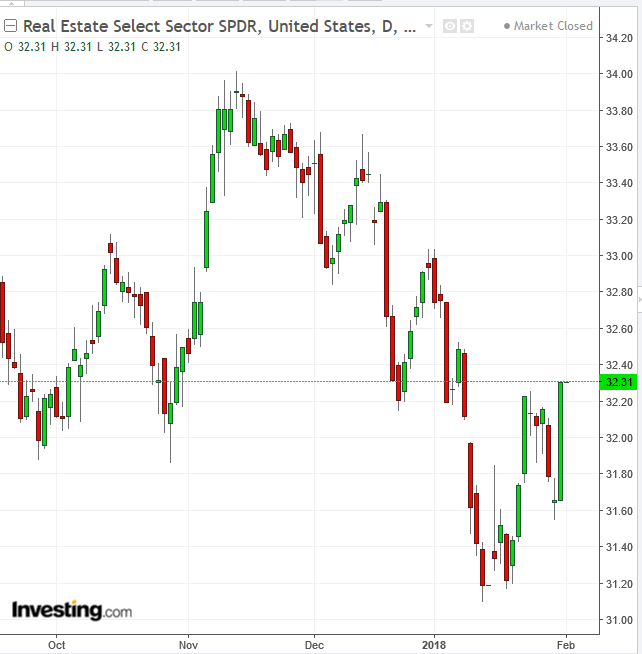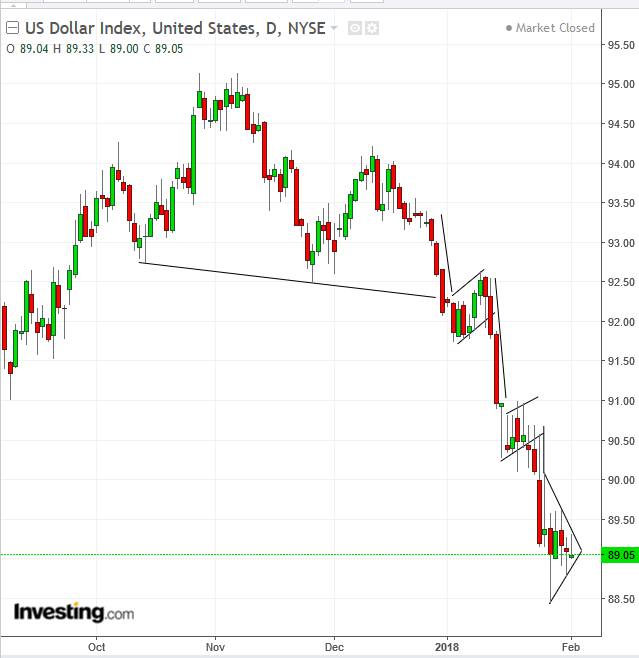- FOMC statement drives volatility, but US stocks finish higher
- Rising yields pose biggest danger to equities
- Small caps yesterday's only losers
- Sterling rises for a third day
- Oil keeps advancing
- Bitcoin falls below $10K
Yesterday, US stocks whipsawed after the Fed announcement but—save for the Russell 2000—all major US indices closed higher on the day, for the first time this week. After its worst two-day setback since May, the S&P 500 finished the month of January on a high, gaining 150.2 points, or 5.6 percent. It was the best first month of the year, in percentage points, for the index since January 1997, when it gained 54.52 points, or 6.13 percent.
For the day however, the S&P 500's close wasn't nearly as stellar; the benchmark index eked out a 0.05 percent gain. The Dow Jones Industrial Average climbed 0.28 percent higher. The NASDAQ Composite gained 0.12 percent
Eight out of 10 SPX sectors were green in January, though Real Estate lost 3.89 percent and Utilities were down 4.18 percent.

The two sector outperformers were Consumer Discretionary, which added 9.60 percent and Health Care which moved higher by 8.09 percent, even after enduring a three-day selloff as the month wound down, including yesterday’s 1.43 percent decline to lose 3.75 percent over the course of the slide.
Had Amazon (NASDAQ:AMZN) and partners Berkshire Hathaway (NYSE:BRKa) and JP Morgan (NYSE:JPM) announced their plans to disrupt healthcare in China—where tech giants such as Alibaba (NYSE:BABA) and Tencent (OTC:TCEHY) have been driving such initiatives for years—rather than in the US where the move is truly novel, the tech sector would have easily outperformed.

On the other hand, had Real Estate not rebounded by 2.06 percent from a 4-of-5 day decline, it would have easily been the worst sector for the month.
Key Events

The Russell 2000 fell 0.54 percent, capping a three-day selloff, closing below the uptrend line since November 15. The 1,560 level is presumed to call in buy orders, after early December and early January sellers were wiped out.
The seesawing that followed the Fed's announcement projected current investor indecision regarding where markets are headed next and whether the Fed will stick to its three rate hike agenda for 2018. While most analysts agree that the Fed took a step closer to its next rate hike yesterday, different media outlets seemed to focus on different aspects of the statement, potentially forming different investor biases.
The New York Times emphasized that the decision to hold steady in January, while widely expected, underscored that the Fed still regards the US's economic expansion as fragile and in need of assistance. Bloomberg underlined the changes to the FOMC statement, acknowledging stronger growth and more confidence that inflation will rise to the 2 percent target. Officials also said inflation “is expected to move up this year and to stabilize” around the goal, in phrasing that marked an upgrade from December.

The yield on the US 10-year note has risen to as much as 2.75 percent, the highest since April 2014. It climbed higher after the Treasury announced it planned to increase the amount of long-term bonds it will sell this quarter, a result of the worsening budget deficit due to the recent tax cuts. The dollar briefly rallied before reversing.
Ironically, while US bonds have had their worst start to a year since 2009, January was the biggest month for stocks in decades which potentially also points to future equity weakness. 'Buy low, sell high' is perhaps the most famous Wall Street maxim. Stock prices become less attractive the more expensive they become, while bonds become more attractive the cheaper they become. The better stocks perform and the worse bonds perform, the higher the probability investors will rotate back out of stocks and into bonds.
This morning, stocks in Europe followed stocks in Asia, which followed yesterday's US stock action higher. In yesterday's post, we suggested that investors must decide whether stronger corporate earnings, faster economic growth and optimism about the US tax cuts are enough to keep propping up equity prices after a year in which a staggering number of new record highs were hit. Investors seem to have decided that indeed, these factors are enough to alleviate their concerns about the recent jump in bond yields, even as Treasuries resume their slide and yields rally.
Global Financial Affairs
Stocks in Asia kicked off the new month with a recovery from a three-day selloff. Japan's TOPIX outperformed although India’s Sensex and mainland China’s Shanghai Composite and Shenzhen Composite indices bucked the trend.
The Sensex dropped alongside the rupee after reports that India's government proposes a long-term capital gains tax on investments in equities. That's ironic, but also jarring when firms in the US are just starting to enjoy the much talked about tax cuts. The Shanghai Composite lost 1 percent; domestic, smaller cap stocks listed on the Shenzhen Composite dropped 3 percent, to a six-month low. The information technology and healthcare sectors were the hardest hit, with dozens of stocks on both exchanges losing 10 percent in value.
Investors are concerned about tight liquidity and poor earnings, even as state funds are ready to step in if the slide continues. Still, the regional, MSCI Asia Pacific Index pushed higher. The Stoxx Europe 600 Index headed for the first advance in four days, led by banking and technology shares.

The dollar—after plunging 3.28 percent in January, its worst month since March 2016, when it fell 3.62 percent—remains steady right now, as investors take a breather while trying to decide where the reserve currency may head next and contracts change hands for the third time since the USD's end-of-year top.

The pound gained for a third day, trading at the top of its session, above the January 24, 1.4243 close, its highest since June 23, 2016, the day before the Brexit election results became public. A high above the 1.4345 January 25 peak would signal a resumption of cable's uptrend.

The price of WTI extended after last month’s 7.37 percent gain, its most since September. A higher price than the January 25 peak of $66.66 is the level that needs to be beaten to confirm the uptrend.
Bitcoin provided a downside breakout to a continuation pattern within a downtrend on Tuesday. Today it dipped below the psychological $10,000 level but managed to close above the key level, forming a weak hammer (weak, because it’s small and has an upper small shadow). Currently, it is trading below the round number barrier, at $9,874, with the January 17, $9,231.10 trough as the next test. See this post for trading strategies.
Up Ahead
- U.S. employers probably added more jobs in January than a month earlier, economists forecast before the Friday report.
- Technology earnings continue today with Alibaba (NYSE:BABA) expected to report Q4 2017 earnings before market open, with a consensus EPS forecast of $1.42
- Apple (NASDAQ:AAPL) is scheduled to report Q4 2017 earnings after market close with a $3.82 EPS forecas
- Alphabet (NASDAQ:GOOGL), which also reports after the close is to report a $10.12 adjusted-earnings per share on revenues of $25.67 billion, growth of 8 percent and 30 percent YoY respectively
- Amazon will report earnings after market close for the fiscal quarter ending Dec. 2017 with a $1.85 EPS forecast
Market Moves
Stocks
- The Stoxx Europe 600 Index gained 0.5 percent as of 8:23 London time (3:23 New York time), the largest rise in almost two weeks.
- S&P 500 Futures increased 0.3 percent.
- The MSCI Asia Pacific Index advanced 0.4 percent, the largest gain in more than a week.
- The UK’s FTSE 100 advanced 0.1 percent.
- The MSCI Emerging Markets Index decreased 0.2 percent.
Currencies
- The Dollar Index lost 0.16 percent.
- The euro rose 0.1 percent to $1.2429, the strongest in more than three years.
- The British pound jumped 0.3 percent to $1.4236, the strongest in more than a week.
- The Japanese yen declined 0.3 percent to 109.56 per dollar, the weakest in more than a week.
- South Africa’s rand declined 0.2 percent to 11.8784 per dollar.
- The MSCI Emerging Markets Currency Index Index fell 0.2 percent.
Bonds
- The yield on 10-year Treasuries gained four basis points to 2.74 percent, the highest in almost four years.
- Germany’s 10-year yield advanced three basis points to 0.73 percent, the highest in more than two years.
- Britain’s 10-year yield climbed four basis points to 1.548 percent, reaching the highest in 21 months on its seventh straight advance.
Commodities
- West Texas Intermediate crude advanced 0.2 percent to $64.84 a barrel.
- Gold fell 0.4 percent to $1,339.62 an ounce.
